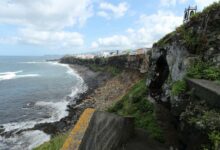Why scientists are in Newfoundland to figure out — and bottle — fog
An international team of scientists is in Newfoundland to gather fog samples from the province’s notorious rain, drizzle and fog in order to better understand the weather element.
The project, called C-Fog and led by the University of Notre Dame in Indiana, is a collaboration of Canadian and U.S. universities, the military in each country and other institutions.
Newfoundland is one of the top three locations in the world for fog, both in how much is generated and how long it hangs around, according to Ed Creegan, chief scientist aboard the U.S. research vessel Hugh R. Sharp.
“From a forecasting standpoint, it’s very difficult to predict when and the duration of how it’s going to form, but it has a huge impact — not only economic impact, on the disruption of transportation from aviation to trucking kind of concerns — but also life, health and safety issues, in that it can come on very suddenly, and disrupt automobile traffic and cause accidents and loss of life,” Creegan told CBC’s On the Go.
“If you were to evaluate it against the more newsworthy things like tornadoes or lightning storms, fog is actually more disruptive overall than either of those two events.”
The ship is outfitted with about a dozen instruments to measure the water content, size and particle count of fog — which Creegan calls “one of the more poorly understood phenomenon in weather.”
The goal? Figure out fog, “To learn what fog is doing and how it’s forming, how it’s dissipating, and try to find the triggers as to give you a better ability to put it into a model so that the model predictions will become more accurate and more timely, and then you translate an enhancement in the model directly into the forecasting,” Creegan said.
At sea, the crew has set a zigzag pattern for the ship as it travels 12 nautical miles from shore parallel to the Avalon Peninsula in search of fog. The scientists aboard are on call 24/7.
It may sound like a bad joke from the 1970s, but the project even demands bottling fog so it can be analyzed later in a lab.
The project requires land resources, too. Instruments have been set up at sites in Ferryland, Blackhead, Flatrock and at Osbourne Head, N.S., to capture how fog comes ashore.








Redes Sociais - Comentários